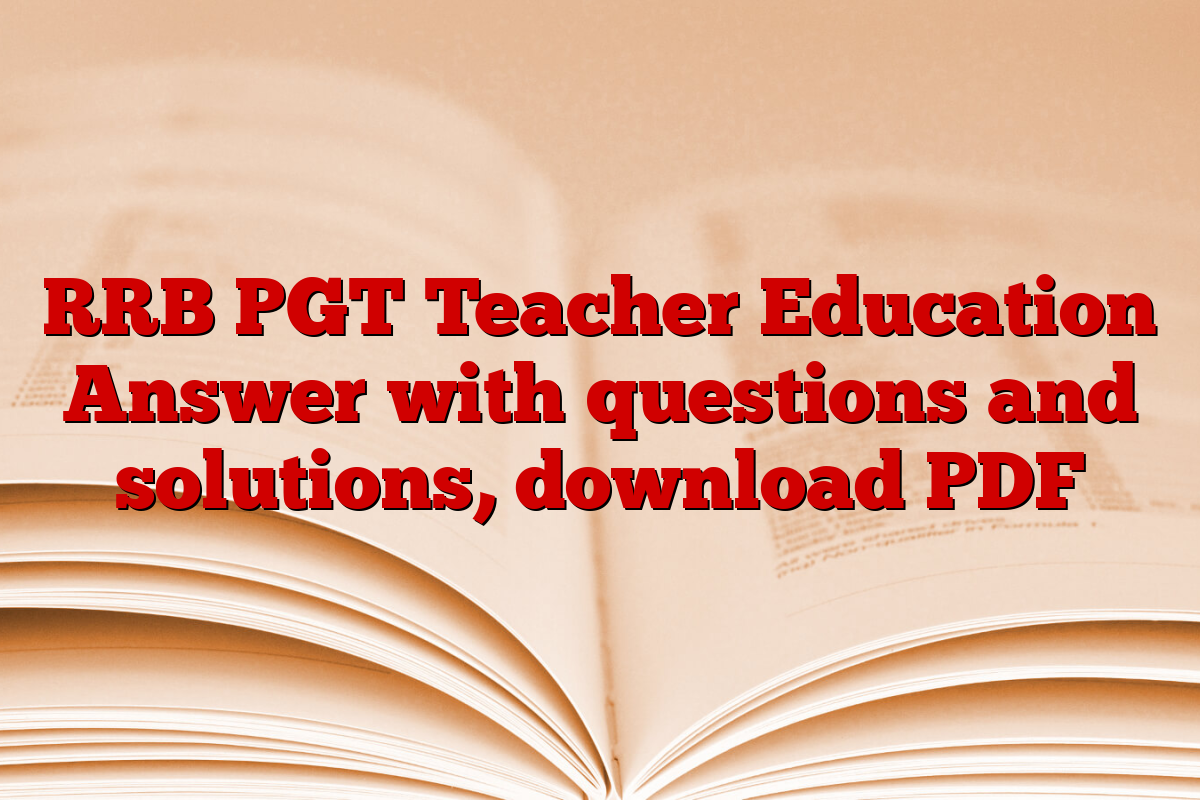Railway Recruitment Board (RRB) is conducting the Railway Teacher Examination for the recruitment of teachers for government schools under Indian Railways. Candidates applying for PGT education status should prepare strictly to secure their selection. To help candidates in this section, we have compiled a set of RRB PGT education questions with detailed solutions. These questions are based on the official course and will help candidates evaluate their knowledge and teach merit effectively.
RRB PGT Answer with Teacher Education Questions and Solutions
Practicing these RRB PGT education questions will help the candidates to get acquainted with the type of questions faced by them in the pattern of the exam and the type of questions. These questions are designed to mimic the actual examination environment, which gives candidates a clear idea of the need for difficulty level, question format and time management. By solving these, candidates can identify their strength and weaknesses, improve their accuracy, and increase their confidence. This practice serves as an entrance for effective preparation, ensuring that they are well prepared to deal with the exam with a strategic approach.
RRB PGT Teacher Education Question
To increase the preparation of the RRB PGT Teacher Exam, we have compiled a set of 30 important education questions alliance with the official course. These questions cover key topics such as educational psychology, teaching-teaching principles, courses and instructions and educational management. There are 10 sample questions for the practice below, and the full 30-pronouncement PDF can be downloaded from the link given below.
Q1. Which of the following principles of development is that development moves in the direction ‘head to toe’?
(A) Principle of continuity
(b) Theory of heredity
(c) Safelo-adult theory
(d) proximo-distilled principle
Q2. Choose the correct option based on the claim and reason given
Claim: Development refers to physical changes, while development refers to psychological and behavioral changes.
Reason: Development mainly involves changes in body shape, size and structure, while development involves changes in cognitive, emotional and social aspects.
(A) Both claims and reasons are true, and the reason is the correct interpretation of the claim.
(b) Both claims and reasons are true, but the reason for this is not the correct explanation of the claim.
(c) The claim is true, but the reason is false.
(d) The claim is incorrect, but the reason is true.
Q3. Which intellect does not include Gardner’s principle of intelligence?
(A) Intraperson
(b) naturalist
(c) Emotional
(d) Exist
Q4. Creativity is usually connected:
(A) over -activation
(b) Low understanding
(c) convergence thinking
(d) Division Thinking
Q5. A 16 -year -old child scores 75 in IQ Test. His mental age will be __________ year.
(a) 8
(b) 14
(c) 15
(d) 12
Q6. Ivan learns by classical conditioning theory proposed by Pavlov ____________.
(A) reinforcement
(b) Association
(c) copy
(d) insight
Q7. Who introduced the concept mapping in education?
(A) Carl Jung
(b) Martin E. Celligan
(c) Noam J. Chomski
(d) Joseph D. Novak
Q8. Surishi is a student of class two. He was taught basic mathematics by the teacher. While shopping the next day, he pointed to a mistake made by the shopkeeper. What kind of learning is this?
(A) negative transfer
(b) positive transfer
(c) Bilateral transfer
(d) zero transfer
Q9. Albert Bandura’s reciprocal determinism model consists of the following three factors
(A) behavior
(b) person
(c) genetic
(d) Environment
Q10. Emphasis: Personal inspiration plays an important role in learning.
Reason: When individuals are motivated and desire to learn, they are more likely to be actively engaged in the learning process and maintain information effectively.
(A) Both claims and reasons are true, and the reason is the correct interpretation of the claim.
(b) Both claims and reasons are true, but the reason for this is not the correct explanation of the claim.
(c) The claim is true, but the reason is false.
(d) The claim is incorrect, but the reason is true.
Solution
S1. Year.
S2. Year.
S3. Year.
S4. Year.
S5. Year.
S6. Year.
S7. Year.
S8. Year.
S9. Year.
S10. Year.
RRB PGT Teacher Education Question Download with detailed solution PDF
We have given a detailed solution to RRB PGT Teacher Education Questions with PDF. Candidates can download these PDFs in Hindi and English, covering the required subjects with detailed explanation for each answer. Practicing these questions will help candidates to increase their subject knowledge, improve accuracy and increase confidence for examination.
RRB PGT Teacher Education Question Download with detailed solution PDF
sharing is Caring!
